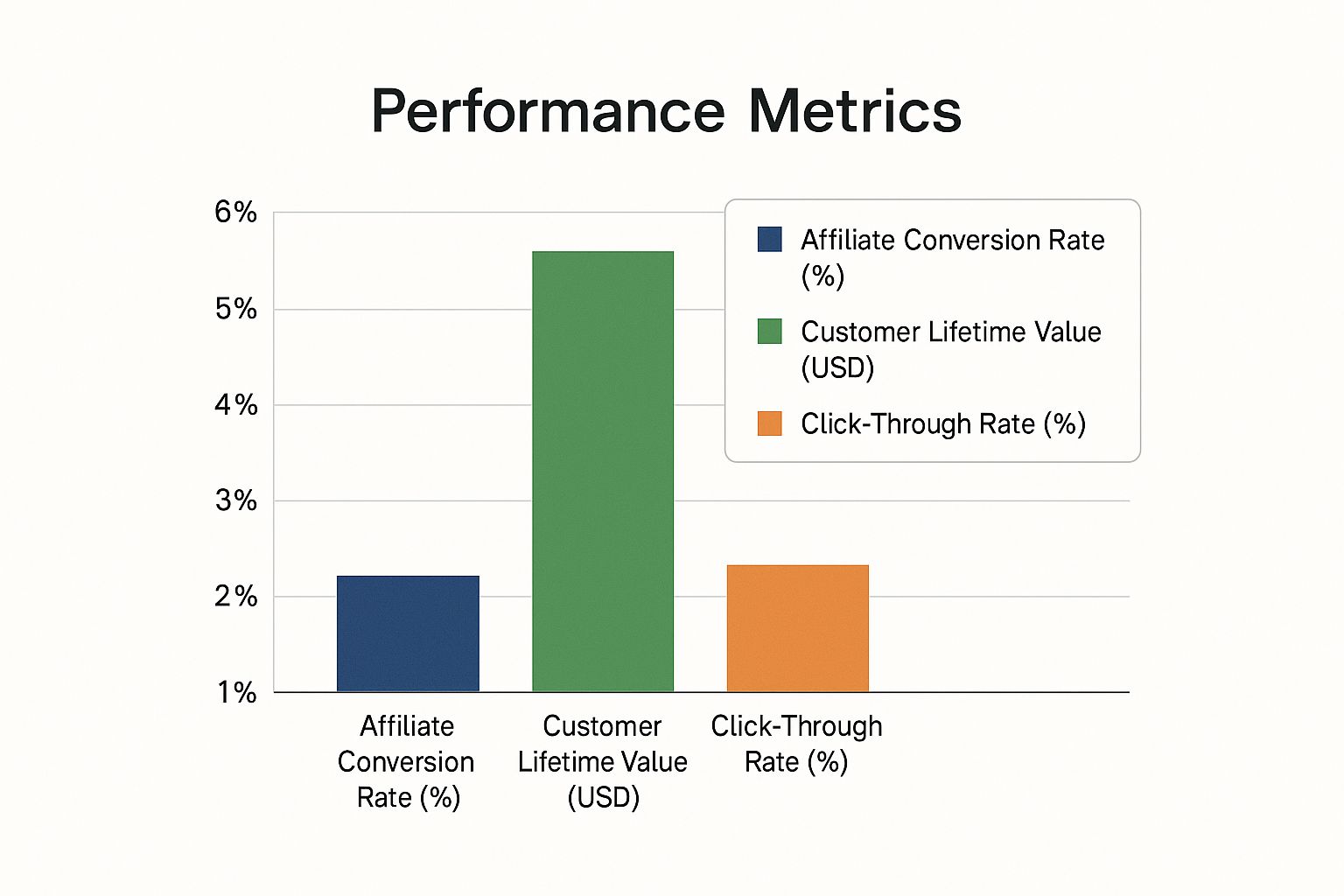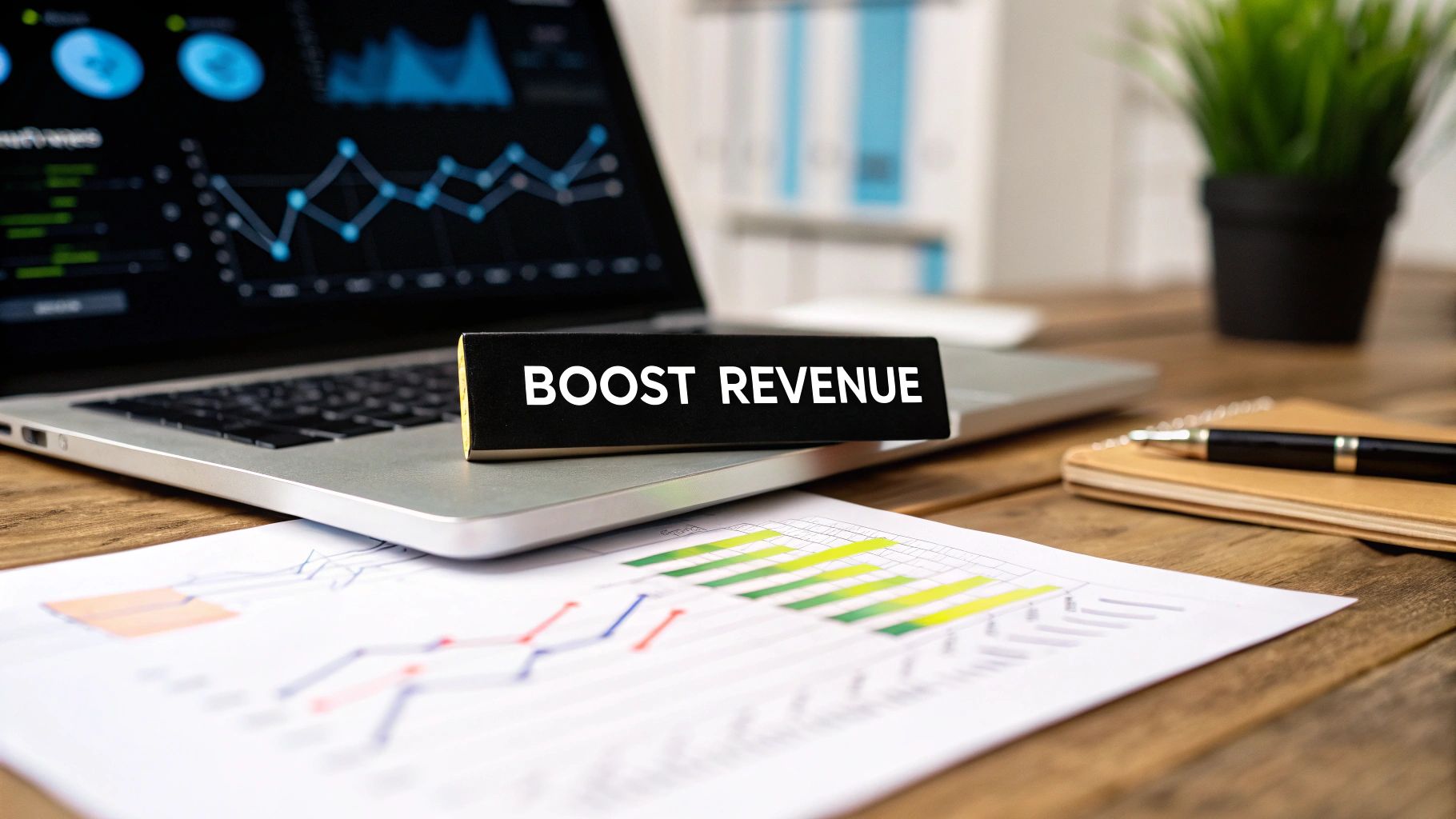Imagine turning your most loyal customers and biggest fans into a dedicated sales team. Now, imagine you only have to pay them after they bring you a new, paying customer. That’s the power of an affiliate program—a performance-based marketing model that can become a scalable, low-risk engine for growth.
Why an Affiliate Program Is Your Next Growth Engine

Before we jump into the nuts and bolts of setting things up with a tool like Refgrow, it's worth taking a moment to appreciate why this channel is such a game-changer, especially for SaaS businesses. Launching an affiliate program isn't just about adding another tactic to your marketing mix; it’s a strategic move to build a community of advocates who are financially invested in seeing you succeed.
The real beauty of this model is how it flips the traditional advertising script. Instead of paying for clicks or impressions and just hoping for the best, you only pay a commission when a referral converts into a paying customer. This structure essentially eliminates the financial risk from your customer acquisition, ensuring every dollar you spend on marketing directly ties to new revenue.
De-Risk Your Marketing Spend
Let's put this into perspective. You could pour $5,000 into paid ads and get a lot of traffic, but there’s absolutely no guarantee those visitors will convert. With an affiliate program, that same $5,000 is only paid out after you've already secured new sales. This makes your growth far more predictable and your marketing budget incredibly efficient.
The core advantage of affiliate marketing is its pay-for-performance structure. It transforms your marketing budget from a speculative expense into a direct investment in profitable growth, aligning your costs perfectly with your revenue.
For SaaS companies, where customer lifetime value (LTV) is often the golden metric, this model is a perfect fit. A single commission payout can secure years of predictable, recurring revenue, making the return on that initial investment ridiculously attractive.
Build Authentic Social Proof
Today’s buyers are savvy. They’re tired of glossy ads and are far more likely to trust a recommendation from someone they already know or follow. When a trusted blogger, industry expert, or fellow professional recommends your software, that endorsement carries a level of authenticity a banner ad could never achieve.
An affiliate program is your way of formalizing this powerful word-of-mouth effect. You're giving your biggest supporters the tools and incentive to champion your brand, generating genuine social proof that builds immediate trust with their audiences. It's less like marketing and more like community building.
Access Untapped Niche Audiences
Your ideal customers aren't all in one place. They're scattered across countless niche blogs, YouTube channels, and online communities that are often tough—and expensive—to reach through conventional channels. But here’s the thing: your future affiliates are already there.
They’ve spent years building credibility and trust within these communities. By partnering with them, you get a warm introduction to highly targeted audiences that might have been completely out of reach otherwise. It’s a shortcut to expanding your market presence in a way that feels organic and welcome. If you want to dive deeper into the fundamentals, it's worth understanding what is affiliate marketing.
To give you a sense of the scale here, the global affiliate marketing industry is on track to blow past $31 billion by 2031, with a compound annual growth rate (CAGR) of 8.00%. This isn't a fleeting trend; it’s a massive, expanding market. For more insights on this growth, you can check out these helpful affiliate marketing statistics and trends on publift.com.
For SaaS leaders looking for a quick overview, here's a breakdown of the core benefits.
Core Benefits of a SaaS Affiliate Program at a Glance
| Benefit | Impact on Your SaaS Business |
|---|---|
| Cost-Effective Acquisition | Pay only for converted customers, dramatically lowering your Customer Acquisition Cost (CAC) and maximizing ROI. |
| Low-Risk Investment | Eliminates upfront marketing costs. Your budget is tied directly to revenue, not clicks or impressions. |
| Authentic Social Proof | Builds trust through genuine recommendations from respected voices in your industry, boosting credibility. |
| Targeted Market Reach | Gain access to niche audiences and new customer segments through your affiliates' established platforms. |
| Scalable Growth Channel | Easily expand your sales force by recruiting more affiliates without increasing your internal team's headcount. |
| Brand Awareness | Increases your brand's visibility and footprint across various blogs, social media channels, and communities. |
In short, a well-executed affiliate program offers a direct path to sustainable, profitable growth by leveraging the power of trusted relationships.
Building the Foundation for Your Program

A great affiliate program doesn't just appear out of thin air. It isn't born from a mass recruitment email or a flashy dashboard. Instead, it starts with a solid blueprint, carefully drafted long before you ever invite your first partner.
This is the crucial planning phase. It’s where you align the program's structure with your core business objectives, making sure it becomes a real growth engine, not just another marketing line item. Think of it like building a house: you wouldn't order the windows before you have the blueprints. In the same way, you can't just pick a commission rate without first defining what success actually looks like.
Setting Clear and Measurable Goals
First things first, you need to move beyond the vague goal of "getting more sales." While revenue is the end game, specific, measurable goals are what guide your decisions and help you figure out what’s actually working.
What do you really want this program to do for your SaaS business?
- Increase Trial-to-Paid Conversion Rate: Maybe your aim is to use affiliates to bump your free-to-paid conversions by 15% within the next two quarters.
- Target a New Customer Segment: Perhaps you're trying to break into the enterprise market. The program's goal could be to acquire 50 new enterprise customers through partners who already have that audience's trust.
- Boost a Specific Product Tier: If you’ve just launched a new “Pro” plan, you could set a goal to drive 30% of all new sign-ups directly to that tier through your affiliate channel.
These kinds of concrete goals give you a yardstick. They inform every decision that follows, from who you recruit to how you pay them. Without them, you’re just flying blind.
Analyzing Competitor Programs
Before you start building, it's always smart to see what the competition is up to. A quick competitive analysis can reveal industry standards and, more importantly, show you where there are gaps you can exploit. Don't just copy what they're doing; look for their strengths and their weaknesses.
Start by picking three to five competitors—direct or indirect—that have affiliate programs. To get a feel for how they present their offer to potential partners, you can explore an example of an affiliate program page and see what information they prioritize.
As you dig in, ask yourself a few key questions:
- What are they offering? Is it a percentage or a flat fee?
- Is the commission recurring (for the life of the customer) or a one-time payout?
- What’s their cookie duration? (How long is a referral tracked after a click?)
- Do they offer performance bonuses or tiered rewards for top performers?
This isn’t about mimicry. It’s about positioning. If everyone else offers a 20% one-time commission, could you offer 15% recurring and attract higher-quality partners who are focused on long-term value? Understanding the landscape lets you create a more strategic and compelling offer from day one.
Designing a Sustainable Commission Structure
Now we get to the heart of your program's foundation: the money. Your commission structure has to hit a sweet spot—attractive enough to motivate affiliates, but sustainable enough that it doesn't sink your profitability.
For a SaaS business, you're typically looking at a few common models:
- One-Time Commission: A single, flat-rate or percentage-based payout for each new paying customer. This is simple and works well for products with a lower lifetime value (LTV).
- Recurring Commission: A percentage of the subscription fee paid out for a set time (like the first year) or for the entire customer lifetime. This is a huge draw for affiliates and perfectly aligns their goals with yours: customer retention.
- Tiered Commission: A structure where affiliates earn more as they sell more. For example, 20% for the first 10 sales, 25% for sales 11-50, and 30% after that. This is great for motivating your top performers.
The ideal commission structure finds the perfect balance between motivating affiliates and protecting your margins. For SaaS, a recurring model often creates the strongest long-term partnerships because it rewards affiliates for bringing in loyal, high-value customers.
When you're crunching the numbers, always factor in your Customer Acquisition Cost (CAC) and LTV. A good rule of thumb is that your affiliate commission should only be a fraction of your LTV, ensuring every single referral is profitable in the long run. Get this financial framework right from the start, and you'll be set up for scalable, profitable growth.
Choosing Your Tech Stack and Getting Started
Alright, you’ve got a solid plan. Now it's time to pick the engine that will actually run your affiliate program. Your tech stack isn’t just some backend software; it’s the central hub where you and your partners will live and breathe. It’s what handles everything from tracking clicks and sales to managing payouts and showing everyone the data.
Choosing the right platform is easily one of the most critical decisions you'll make. A clunky, unreliable system will drive your partners crazy and create an administrative nightmare for you. On the flip side, a seamless, intuitive platform sets everyone up for a win right from the start.
Must-Have Features in an Affiliate Platform
When you start looking at different options, there are a few non-negotiable features you absolutely need. These are the foundations of a program that can actually grow without falling apart.
Try to see it from your affiliate’s point of view. They need a dashboard that’s clean, simple, and gives them real-time stats on how they’re doing. If they can't even find their unique tracking link or see how many clicks they’ve sent, they’ll lose motivation fast.
Here are the essentials to look for:
- Reliable Tracking: This is the absolute cornerstone. The system must accurately track referrals from the initial click all the way to a paid conversion. This often involves cookie-based tracking or unique coupon codes that work flawlessly.
- Automated Payouts: Trust me, you do not want to be manually calculating and sending commissions every month. It’s a surefire way to make mistakes and waste a ton of time. A good platform automates this and connects with payment systems like Stripe or PayPal to handle mass payouts.
- Customizable Commission Rules: The platform has to support the commission structure you designed, whether that’s recurring, one-time, tiered, or some hybrid model. You need flexibility because your program will definitely evolve.
- Branded Affiliate Portal: The partner experience should feel like an extension of your own brand, not some generic third-party service. Look for options to add your logo, match your brand colors, and use a custom domain.
The best affiliate platforms don't just track sales—they create a seamless, branded experience for your partners. When your affiliates feel like they are part of your company, their loyalty and performance skyrocket.
Beyond these core features, think about the future. Trends like AI-driven automation are already changing how top-tier programs operate. For example, AI can help optimize campaigns and provide predictive analytics to improve targeting. If you want to dive deeper, you can discover more insights about affiliate marketing trends on imd.org.
A Practical Walkthrough with Refgrow
To make this less abstract, let’s walk through what the initial setup looks like on a modern platform like Refgrow. It’s built specifically for SaaS, which is a huge advantage because it understands recurring revenue and trial conversions right out of the box.
The first step is usually getting the platform integrated with your website and product. With Refgrow, this is surprisingly straightforward and often just involves adding a single line of code to your application. That lightweight approach means you can get a fully native affiliate portal running inside your product without a ton of development work.
Here’s a look at the Refgrow interface, which gives you an idea of what a clean, intuitive dashboard looks like for both you and your affiliates.
As you can see, a well-designed platform puts the most important information front and center. This makes it easy for partners to track their progress and for you to manage the entire program.
Once you’re integrated, you’ll set up your commission rules. Inside your Refgrow dashboard, you can define your commission percentage or flat rate, set it as recurring or one-time, and decide on the cookie duration. For example, you could easily create a 30% recurring commission for the first 12 months of any new subscription, all tied to a 90-day cookie window.
Next up is customizing the affiliate portal. This is where you upload your logo, tweak the color scheme to match your brand, and set up a custom subdomain like partners.yourcompany.com. This branding is huge for building trust and looking professional.
You’ll also want to upload your marketing assets. Think of this as a "resource kit" to empower your partners. It should include things like:
- Brand Guidelines: A simple guide on how to use your logo and talk about your product correctly.
- Marketing Copy: Pre-written social media posts, email templates, and ad copy they can grab and use.
- Visual Assets: High-quality logos, product screenshots, and promotional banners.
Making these resources easy to find right inside the portal removes a lot of friction and helps your new affiliates start promoting your product effectively on day one. To help you weigh your options, take a look at our guide on the best affiliate marketing platform for a deeper comparison.
Bringing the Right Partners on Board
You’ve laid the groundwork and your program is ready to go. Now for the fun part: finding people to join. An affiliate program is only as good as its partners, so this isn't about casting the widest net you can. It’s about finding people who are a natural fit for your brand and can genuinely connect with their audience about your product.
Think of it less like recruiting and more like building an alliance. You're looking for partners who are already trusted voices in the communities you want to reach. Ten amazing, perfectly aligned affiliates will always outperform a thousand who just don't get it.
Where to Find Your First Affiliates
So, where are these star partners hiding? Probably closer than you think.
Your best first move is to look at your existing customer base. The people who already pay for, use, and genuinely love your SaaS are your most authentic advocates. They get the value because they live it every day, and that kind of enthusiasm is impossible to fake.
Start by sending a personal email to your most active users or those who have left you glowing reviews. A simple invitation to an exclusive partner program can work wonders.
Beyond your own backyard, here are a few other places to look:
- Industry Bloggers & Content Creators: Find the people who are already writing about the exact problems your SaaS is built to solve. Their audience is your audience.
- Complementary SaaS Companies: Team up with other non-competing tools that serve the same customers. It's a classic win-win where you can cross-promote and share audiences.
- Influencers & Thought Leaders: Identify the key people in your niche on platforms like YouTube, LinkedIn, or even Twitter. A single partnership here can put your brand in front of a massive, ready-to-listen crowd.
If you want to dig even deeper, we have a whole guide on how to find affiliates that breaks down even more proven strategies for finding top-tier partners. The main takeaway is to be strategic and proactive with your outreach.
Vetting Your Potential Partners
Once the applications start rolling in, you need a solid process to separate the great from the good. Not everyone is going to be a perfect match, and that’s perfectly fine. Your main job here is to protect your brand by making sure anyone representing you is credible and professional.
When you're looking at a potential affiliate's platform—be it a blog, social profile, or YouTube channel—ask yourself a few simple questions:
- Brand Alignment: Do their vibe and values feel like yours?
- Audience Fit: Are they talking to your ideal customers?
- Content Quality: Is their content sharp, helpful, and professional?
- Engagement: Do people actually listen to them? Look for an active community that trusts their recommendations.
A great affiliate isn't just someone with a huge following; it's someone with the right following. I've seen micro-influencers with small, dedicated audiences run circles around macro-influencers with millions of disengaged followers.
The potential for real earnings is a huge draw. Industry data shows that 81% of advertisers run affiliate programs, and the average affiliate marketer earns around $8,038 per month. This isn't just a side hustle; it's a massive opportunity for partners who are serious about it. You can see more data on this in these affiliate marketing statistics from AffiliateWP.
A Seamless Onboarding Experience
You’ve found a great partner and they’re approved. What now? The onboarding process is your first real chance to impress them and set them up for success. A clunky, confusing start is one of the fastest ways to lose a promising affiliate before they’ve even made their first dollar.
The goal is simple: make it incredibly easy for them to get started. This is where a clean, organized affiliate portal, like the one you can set up in Refgrow, is an absolute game-changer.
Your onboarding should give them a comprehensive resource kit right inside their partner dashboard. Here’s what it absolutely needs to include:
- A Welcome Guide: A quick-start guide covering program rules, how they get paid, and a few best practices.
- Marketing Assets: Give them everything they need—logos, brand guidelines, pre-written copy for emails and social posts, and high-quality product images.
- Product Info: Easy access to links for key features, tutorials, and case studies that will help them explain your product's value.
- Clear Terms & Conditions: No one wants to read a novel of legalese. Make sure your terms are clear, fair, and easy to find.
When you give your partners everything they need right from the get-go, you empower them to start promoting your SaaS with confidence from day one. This small effort up front is what turns new recruits into loyal, high-performing partners for the long haul.
Managing and Scaling Your Affiliate Program
Getting your affiliate program off the ground is a fantastic achievement, but let's be honest—it’s just the starting line. The real work, and the real growth, begins now. This is where you nurture your program from a new marketing channel into a reliable engine for SaaS revenue.
It all boils down to data. You can't fix what you can't see. By focusing on a handful of key performance indicators (KPIs), you'll get a clear, unbiased look at what's working, who your best partners are, and where you can tweak things for better results.
Tracking the Metrics That Matter
Your affiliate dashboard is more than just a sales tracker; it’s your command center. It's easy to get sidetracked by vanity metrics like raw clicks, but the trick is to zero in on the data that actually moves the needle for your business.
Here are the essential KPIs you should have on your radar:
- Affiliate-Driven Conversion Rate: This is the big one. It tells you what percentage of the traffic your affiliates send actually turns into paying customers. If this number is low, it could mean there's a disconnect between the affiliate's audience and your product, or maybe they just need better marketing assets from you.
- Customer Lifetime Value (LTV): Are your affiliates just bringing in trial-kickers, or are they finding customers who stick around for the long haul? For any SaaS business, tracking the LTV of affiliate-referred customers is non-negotiable. It proves the long-term health and profitability of the channel.
- Click-Through Rate (CTR): This shows how many people are actually clicking on the affiliate links. A healthy CTR is a great sign that your partner's promotional content is hitting the mark and grabbing their audience's attention.
The infographic below really brings home how these core metrics paint a full picture of your program's health.

As you can see, a successful program isn't just about one metric. It’s about a healthy balance between a strong conversion rate and a high customer LTV, which tells you you're not just getting customers, but the right kind of customers.
The table below breaks down these KPIs further, giving you actionable ways to improve each one.
Key Affiliate Program KPIs and Optimization Tactics
| Key Metric | What It Tells You | Optimization Tactic |
|---|---|---|
| Affiliate-Driven Conversion Rate | The quality and relevance of affiliate traffic. | Provide better creative assets, offer exclusive discount codes for specific audiences, or help affiliates refine their messaging. |
| Customer Lifetime Value (LTV) | The long-term value and retention of referred customers. | Encourage affiliates to promote annual plans. Share content with them that highlights your product's "stickiest" features. |
| Click-Through Rate (CTR) | The effectiveness of the affiliate's promotional content. | A/B test different call-to-action buttons, provide high-quality banners, and suggest compelling copy for their promotions. |
| Active Affiliates | The overall health and engagement of your partner base. | Run monthly contests, send regular update newsletters, and offer performance-based commission tiers to motivate everyone. |
| Average Order Value (AOV) | The average revenue generated per referred customer. | Incentivize upsells by offering a bonus on higher-tier plan referrals. Create content that showcases premium features. |
Ultimately, consistent monitoring of these metrics is what allows you to make smart, data-backed decisions instead of just guessing what might work.
Keeping Your Affiliates Engaged and Motivated
Remember, your affiliates are your partners. They aren't just rows in a spreadsheet. The best-performing programs I've seen are always built on solid relationships and consistent communication. An affiliate who feels like a valued part of your team will work ten times harder for you.
Just sending out commission payments isn't enough to keep that fire lit. You need to build a sense of community and maybe even a little friendly competition. For a much deeper look at this, check out our full guide on how to effectively manage your affiliate program and keep your partners in the game.
The most successful affiliate programs are managed like a community, not a transaction. Regular communication, performance incentives, and genuine support are what separate a stagnant program from a scalable growth engine.
Here are a few tactics I've seen work wonders for keeping affiliates fired up:
- Run Performance-Based Contests: Nothing sparks action like a good old-fashioned competition. Offer a cash bonus, a great gift card, or even a free year of your top-tier plan to the affiliate who brings in the most sales each quarter.
- Introduce Tiered Commissions: This is a classic for a reason. Reward your heavy hitters by bumping up their commission rate when they reach specific goals. For example, you could jump their commission from 25% to 30% after they refer their 50th customer. It gives everyone a clear goal to shoot for.
- Share Success Stories: When an affiliate does something great, shout it from the rooftops! Feature them in your partner newsletter or on your blog. This not only gives them well-deserved recognition but also shows other affiliates what’s possible and inspires them to raise their own game.
Using Data to Find and Empower Your Top Partners
Your affiliate data will quickly reveal a familiar pattern: the 80/20 rule. I see it time and time again. A small handful of your affiliates—usually around 20%—will be driving 80% of your results. Your number one job is to figure out who these superstars are.
Jump into your Refgrow dashboard and sort your partners by revenue. See who consistently floats to the top of that list? Those are the people you need to build real relationships with.
Don't just send a form email. Reach out to them personally. Get on a call. Ask them what’s working so well for them and what you can do to help them double down on that success. They might have a brilliant idea for a co-hosted webinar, a special coupon code for their audience, or a case study you could build together.
This proactive, data-first approach is the secret to scaling. When you pour your energy into the partners who are already moving the needle, you create a powerful growth loop. You help them win, they bring you more revenue, and your entire program takes off.
Common Questions About Creating an Affiliate Program

If you're thinking about starting an affiliate program, you probably have a lot of questions. That’s a good thing. Getting these foundational pieces right from the start will save you a ton of headaches and help you build a program that's fair, effective, and doesn't become a management nightmare. Let's walk through some of the big questions I see SaaS founders ask all the time.
First up is the classic "build vs. buy" debate. You could technically build a program in-house, but trust me, it's a massive undertaking. You'd need significant development resources to handle tracking, payment calculations, and a partner dashboard.
Honestly, for 99% of SaaS businesses, grabbing a specialized platform is the only practical way to go. It’s faster, more scalable, and lets you focus on your product, not on building a complex tracking system.
How Much Should I Pay in Commissions?
This is the big one, and the honest answer is: it really depends on your business model. The goal is to find that sweet spot—a rate that genuinely motivates affiliates but doesn't sink your margins.
For SaaS, a great starting point is typically a 20% to 30% recurring commission for the first year of a customer's subscription.
Take a hard look at your Customer Lifetime Value (LTV) and Customer Acquisition Cost (CAC) to make sure the numbers work. Offering a recurring commission is powerful because it aligns your partners' goals with yours. They're incentivized to bring in loyal customers who stick around, which is a win-win.
Your commission structure is your single most powerful recruitment tool. A competitive, fair, and easy-to-understand commission plan will attract high-quality partners and set the foundation for a successful, long-term program.
What Is a Cookie Duration and Why Does It Matter?
A cookie duration—sometimes called a cookie window—is simply the amount of time an affiliate has to get credit for a sale after someone clicks their link. If you set a 30-day cookie, and a user clicks a link then buys anytime in the next 30 days, the affiliate earns their commission.
Longer is almost always better here. The SaaS sales cycle isn't like buying a t-shirt; people sign up for trials, get their team to test it, and might take weeks before they pull out the credit card.
A cookie window of 60 to 90 days is a competitive standard. It shows affiliates you understand how your customers buy and gives them a fair shot at earning what they deserve.
How Do I Handle Affiliate Payouts?
Trying to manage payouts with spreadsheets and manual bank transfers is a quick way to lose your mind and your best partners. This is another area where a solid platform like Refgrow becomes a non-negotiable. An effective system should automate the whole process, from commission math to mass payments.
Make sure whatever platform you choose integrates with payment processors like Stripe or PayPal. This lets you schedule and send payments to everyone with just a few clicks. Nothing builds trust like paying people accurately and on time.
Finally, you need crystal-clear terms and conditions from day one. Be sure to cover the essentials:
- Payout Threshold: The minimum an affiliate needs to earn before you send a payment (e.g., $50). This prevents you from processing tons of tiny transactions.
- Payment Schedule: When do you pay? A common one is net-30, meaning you pay out 30 days after the end of the month in which the sale occurred.
- Prohibited Activities: Spell out the rules. No self-referrals, no bidding on your brand name in Google Ads—get it all in writing.
Ready to launch a powerful, native affiliate program for your SaaS in minutes? With Refgrow, you can embed a fully branded partner dashboard directly into your product with just one line of code. Start turning your loyal users into a powerful growth engine today. Get started with Refgrow.

